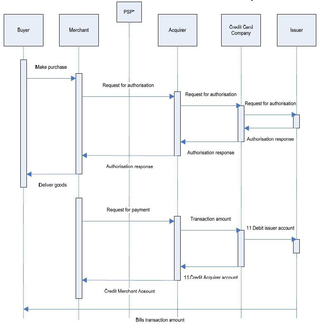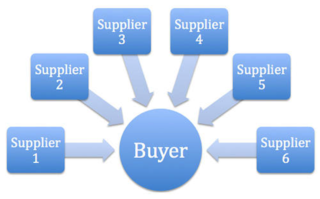E-commerce is the activity of electronically buying or selling products on online services or over the Internet. E-commerce draws on technologies such as mobile commerce, electronic funds transfer, supply chain management, Internet marketing, online transaction processing, electronic data interchange (EDI), inventory management systems, and automated data collection systems. E-commerce is the largest sector of the electronics industry and is in turn driven by the technological advances of the semiconductor industry.

Marketing is the act of satisfying and retaining customers. It is one of the primary components of business management and commerce.

eBay Inc. is an American multinational e-commerce company based in San Jose, California, that brokers customer to customer and retail sales through online marketplaces in 190 markets worldwide. Sales occur either via online auctions or "buy it now" instant sales, and the company charges commissions to sellers upon sales. eBay was founded by Pierre Omidyar in September 1995. It has 134 million yearly active buyers worldwide and handled $74 billion in transactions in 2022, 49% of which was in the United States. In 2022, the company had a take rate of 13.25%.

Sales are activities related to selling or the number of goods sold in a given targeted time period. The delivery of a service for a cost is also considered a sale. A period during which goods are sold for a reduced price may also be referred to as a "sale".

Disintermediation is the removal of intermediaries in economics from a supply chain, or "cutting out the middlemen" in connection with a transaction or a series of transactions. Instead of going through traditional distribution channels, which had some type of intermediary, companies may now deal with customers directly, for example via the Internet.

An online auction is an auction held over the internet and accessed by internet connected devices. Similar to in-person auctions, online auctions come in a variety of types, with different bidding and selling rules.

Business-to-business is a situation where one business makes a commercial transaction with another. This typically occurs when:
B2B e-commerce, short for business-to-business electronic commerce, is the sale of goods or services between businesses via an online sales portal. In general, it is used to improve the efficiency and effectiveness of a company's sales efforts. Instead of receiving orders using human assets manually – by telephone or e-mail – orders are received digitally, reducing overhead costs.
Business marketing is a marketing practice of individuals or organizations. It allows them to sell products or services to other companies or organizations that resell them, use them in their products or services, or use them to support their works. It is a way to promote business and improve profit too.
An online marketplace is a type of e-commerce website where product or service information is provided by multiple third parties. Online marketplaces are the primary type of multichannel ecommerce and can be a way to streamline the production process.

Bob Shop, formerly Bidorbuy or bidorbuy.co.za, is a South African e-commerce website based on an internet auction and online marketplace model allowing individuals and businesses to trade with each other. Transactions on bidorbuy are in South African rands.
Consumer-to-business (C2B) is a business model in which consumers (individuals) create value and businesses consume that value. For example, when a consumer writes reviews or when a consumer gives a useful idea for new product development then that consumer is creating value for the business if the business adopts the input. In the C2B model, a reverse auction or demand collection model, enables buyers to name or demand their own price, which is often binding, for a specific good or service. Inside of a consumer to business market the roles involved in the transaction must be established and the consumer must offer something of value to the business.
Business-to-employee (B2E) electronic commerce uses an intrabusiness network which allows companies to provide products and/or services to their employees. Typically, companies use B2E networks to automate employee-related corporate processes. B2E portals have to be compelling to the people who use them. Companies are competing for eyeballs of their employees with eBay, yahoo and thousands of other web sites. There is a huge percentage of traffic to consumer web sites comes from people who are connecting to the net at the office.

iOffer was a San Francisco-based online trading community that was launched on May 1, 2002 by Steven Nerayoff. As of February 2008, it claimed to have nearly one million total users, including approximately 75,000 sellers, although this information cannot be independently verified, nor is it known how many of these users are active.

Pricefalls, LLC was an American Internet company that managed Pricefalls.com, an on-line retail marketplace, and PFTech, a leading marketplace platform developer. In 2019, Pricefalls, LLC was acquired by Loblaw, Canada's largest retailer.

Electronic commerce, commonly known as e-commerce or eCommerce, or e-business consists of the buying and selling of products or services over electronic systems such as the Internet and other computer networks. The amount of trade conducted electronically has grown extraordinarily with widespread Internet usage. The use of commerce is conducted in this way, spurring and drawing on innovations in electronic funds transfer, supply chain management, Internet marketing, online transaction processing, electronic data interchange (EDI), inventory management systems, and automated data collection systems. Modern electronic commerce typically uses the World Wide Web at least at some point in the transaction's lifecycle, although it can encompass a wider range of technologies such as e-mail as well.

A reverse auction is a type of auction in which the traditional roles of buyer and seller are reversed. Thus, there is one buyer and many potential sellers. In an ordinary auction also known as a forward auction, buyers compete to obtain goods or services by offering increasingly higher prices. In contrast, in a reverse auction, the sellers compete to obtain business from the buyer and prices will typically decrease as the sellers underbid each other.
Tmall, formerly Taobao Mall, is a Chinese-language website for business-to-consumer (B2C) online retail, spun off from Taobao, operated in China by Alibaba Group. It is a platform for local Chinese and international businesses to sell brand-name goods to consumers in Greater China. It has over 500 million monthly active users, as of February 2018. In the last few years, it has opened its features to brands, not only for online sales but also for developing brand awareness. According to Alexa Rank, it is the third most visited website globally in 2021.
E-commerce or electric commerce in Southeast Asia is the buying and selling of products and services over the internet in the countries of Southeast Asia. These practices reached Southeast Asia during the dot-com mania in the 1990s. After the dot-com bust, local e-companies have seen promising growth in this sector.
There are many types of e-commerce models', based on market segmentation, that can be used to conducted business online. The 6 types of business models that can be used in e-commerce include: Business-to-Consumer (B2C), Consumer-to-Business (C2B), Business-to-Business (B2B), Consumer-to-Consumer (C2C), Business-to-Administration (B2A), and Consumer-to-Administration










